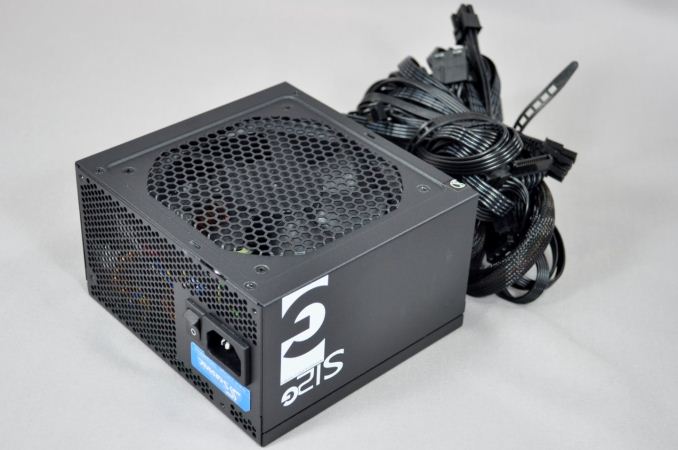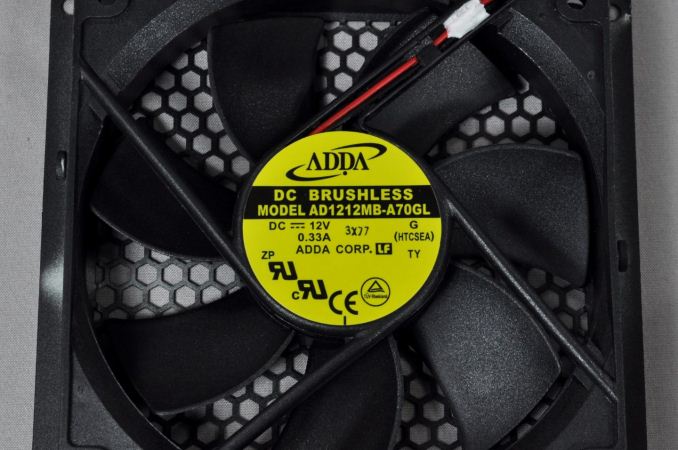Seasonic S12G 650W Power Supply Review
by E. Fylladitakis on February 28, 2014 2:20 PM EST- Posted in
- Cases/Cooling/PSUs
- Seasonic
- 80 Plus Gold
External Appearance
The Seasonic S12G sports a small, typical ATX-sized (140mm) chassis that has been sprayed with a matte black paint. Some effort has been made to improve the appearance of the power supply, albeit not all of the measures can be considered successful. Seasonic uses all-black ribbon cables, with the exception of the 24-pin ATX cable that uses typical color-coded wires and sleeving. A blue sticker has been placed on the rear of the unit, where it will be visible from the back of a case once the PSU has been installed. Oddly enough however, the company sprayed the series logo in white on the right side of the chassis, where it will be facing the right side panel of a case. It goes without saying that it will not be visible inside the vast majority of the cases currently in the market. On the other hand, the sticker with the specifications of the PSU has been placed on the left side of the chassis. No effort has been made at all to enhance the top side of the chassis visually, so in a bottom-mounted location users with case windows will simply see a black surface.
Internal Design
We were surprised the instant that we opened up the chassis of the S12G 650W unit. The unit is cooled by an ADDA AD1212MB-A70GL fan, unlike the majority of Seasonic's other models that use SanAce fans. The particular fan model is high quality, featuring a "Hypro" liquid bearing and with a maximum speed of 2050 RPM, yet it is no SanAce. When you have to compete in the mainstream market and even a few dollars can make an immense difference on sales, you have to keep the retail price as low as possible, which is most probably why Seasonic went with the ADDA fan for the S12G. Note also that as this unit has no fanless mode, it does not require a fan with extraordinary specifications (e.g. a very low starting voltage).
It is obvious that the OEM behind the S12G is Seasonic, as the company designs, manufactures, and markets their own units. We spot four heatsinks; the smallest one handles the rectifier bridge, the one near the edge of the PCB cools the active PFC components, and those on each side of the main transformer handle the inversion and conversion transistors of the primary and secondary stage respectively. The input filter begins on the PCB attached to the back of the receptacle, but continues on the main PCB until the input of the rectifier bridge. We spot a total of six Y capacitors, two X capacitors, and two filtering inductors, which form an excellent intake filter.
In terms of component and build quality, Seasonic does not let us down. The primary capacitor and most of the smaller capacitors are supplied by Nippon Chemi-Con, with some Rubycon electrolytic capacitors after the secondary side heatsink as well. Everything is well shielded and secured with glue, ensuring the mechanical cohesion of the unit. The inductors are glued and also tightened with cable ties, in order to minimize the chance of vibration-generated noise (also known as "coil whine"). The quality of the soldering is very good, well above what we would consider average. There are a few spots where excessive solder has been applied, but that hardly is worth commenting on in a $90 MSRP PSU.






















77 Comments
View All Comments
WithoutWeakness - Friday, February 28, 2014 - link
I think that was the point. The only real flaw with this unit is that it got fairly warm before the fan kicked into high gear in the hot box testing, which is already grasping at straws to find a flaw with this unit. The only feasible scenario where that sort of issue would arise would be if you were running the PSU at or near full load for a long time (such as powering a mining rig) and had it installed in a case with poor airflow. Given that no one in their right mind would build their mining rig in such a case it should be a non-issue for this power supply and can safely be overlooked.yhselp - Friday, February 28, 2014 - link
When looking for a silent/fanless PSU why not just buy a Corsair AX760 (non-i)? It's practically fanless until about 530W.Egg - Friday, February 28, 2014 - link
Perhaps because it's $170 ($150 after rebate) on Newegg?Daniel Egger - Friday, February 28, 2014 - link
So when will we get reviews of no-nonsense PSUs? 650W? Really? I don't even have so many computers in one place I could put together behind such a thing... Since the graphs start around 5% which should be 32.5W which is more than my systems consume when idle I'm wondering what would happen below that, is the efficiency just abysmal or wouldn't it even run stable?JarredWalton - Friday, February 28, 2014 - link
Are you running laptops or NUCs? Because getting down to 32W on any decent system that has a discrete GPU and a standard voltage CPU is pretty difficult. My own Haswell setup (granted, with two GPUs) idles at more than twice that amount. The difficulty is in getting the PSU companies to send in lower wattage units, and in finding good quality lower wattage PSUs as well (that don't break the bank). A 75% efficient PSU putting out 30W draws 40W whereas a 90% efficient PSU with the same output draws 33.3W -- you could save 7W per system with the higher efficiency. Woot? But regardless, it's the other aspects (noise, ripple, voltage regulation, and sound levels) that are generally more important than efficiency.There's a corollary to this as well: if you're running a system that only draws 30W of power at most, how important is the PSU? There's a reason the lowest wattage 80 Plus Platinum PSUs on Newegg start at 400W and are relatively uncommon. I count five Platinum PSUs rated at less than 500W, seven at 500-550W, and another seven 600-660W. In theory, few people need more than that, and yet there are another 28 Platinum models that are rated at 700W or higher. And of course, the least expensive 80 Plus Platinum PSU is a $90 550W model with the 400W Seasonic SS-400FL2 (granted, fanless) priced at $120. Paying more for "less" would be a tough sell, and creating a high quality PSU often has a minimum cost that ends up being more than most users would pay, regardless of how good it might be. So, we end up with most of the real quality PSUs being rated at much higher wattages than most of us use/need/want.
Daniel Egger - Friday, February 28, 2014 - link
> Are you running laptops or NUCs?No, just regular systems. My homeserver is pulling 35W from the wall right at this moment. It's a Core i5-2500 (95W) running Xen and a couple of VMs, has 3 NICS, 12GB of RAM in 4 slots, 1 7200 RPM drive and a Samsung 830 SSD. It's a Fujitsu build with some Fujitsu branded 280W power supply rated with 83% efficiency at 20% load, there's even a successor available that's rated with 88% efficiency at 20% load.
My notebook with discrete AMD 6750 draws even less than that in idle.
> But regardless, it's the other aspects (noise, ripple, voltage regulation, and sound levels) that are generally more important than efficiency.
I could hardly disagree more. Where I live at the moment each Watt consumed 24/7 costs me 2,20€ per year and the prices know only one direction... Of course there're potentially also additional costs that have to be considered like UPS and cooling which are not even on a linear scale for investment costs...
20€ more for a a mere 5W constant power saving are a complete nobrainer...
Sure power quality and noise are interesting aspects for a PSU but unless you have a total lemon they're usually perfectly fine so the only really interesting aspect of a PSU is the efficiency at the target workload.
I'm also quite certain that someone who fires up a gamers rig with dual/quad GPU and generally wasteful components really doesn't give a crap whether a PSU does 80 or 85% at 600W. For sane persons with normal systems it does matter quite a bit though, or at least it should...
Sleepingforest - Friday, February 28, 2014 - link
First of all, a gaming rig's efficiency is going to matter more, if anything, since all it does is run full tilt, and that's where every percent matters most when it comes to savings (although, even in places 2-3x more electrically expensive than the US, it is very difficult to save money with higher rated PSU). I actually only have mine either completely on and gaming, or totally unplugged.Second of all, the vast majority of PSUs have terrible efficiency when the load drops to a very low percentage of it's capacity--even units like a SFX 300W unit (here: http://www.jonnyguru.com/modules.php?name=NDReview... can only pull around 80% efficiency at loads around 30W. It's just not part of the average PSU's design to perform very well at that low of a load.
Daniel Egger - Saturday, March 1, 2014 - link
> First of all, a gaming rig's efficiency is going to matter more, if anything, since all it does is run full tilt,If someone's seriously into buying gear that *wastes* >>50W just to squeeze out a few additional fps this person really don't care about efficiency at all. It's like buying a Porsche and then making sure it runs completely on renewable fuel to do something good for the environment...
> Second of all, the vast majority of PSUs have terrible efficiency when the load drops to a very low percentage of it's capacity
That's exactly the reason why it is important to have good low capacity units. Because the higher the rating the worse it will perform at low load, a) because there's something like a base consumption every "on" unit will have for the transformer and all the switching electronics which highly depends on the maximum load and b) it's not impossible but really costly to optimise a PSU for a wide band of loads and since usual certification labels only require testing at certain loads this is where the optimisation effort will be put in
For the vast majority of people even a 300W PSU is complete overkill because *typical* load will be much closer to 20% than 50% or even 80% and idle far below that.
emn13 - Saturday, March 1, 2014 - link
Sideline: biofuels can have a slightly higher energy density than normal conventional fuel (though I doubt it's enough to make much difference, and I bet there's tuned conventional fuel that's just as good), so you might use a sports-car with biofuel for performance rather than environmental reasons.Pcgeek21 - Friday, February 28, 2014 - link
I agree with Daniel; I would be very interested in the performance/efficiency of low wattage power supplies (200W-300W peak output). I run relatively low power servers at home 24/7 such that the 5W delta in power draw can add up over the 4-5 year lifetime of the equipment.I purchased an Antec EarthWatts EA-450 (http://www.eteknix.com/antec-earthwatts-platinum-4... several months ago for my current server. I would be very interested in determining if it was a worthwhile investment or if there are any better alternatives available on the market.
I look forward to more PSU reviews.